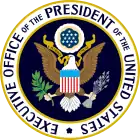White House Initiative on Asian Americans and Pacific Islanders
The White House Initiative on Asian Americans and Pacific Islanders is a United States governmental office that works to empower Asian Americans and Pacific Islanders (AAPIs) to improve the quality of their lives, raise the standard of living of their families and communities, and more fully participate in our economy. The Initiative also works with the Native Hawaiian community. The Initiative collaborates with the White House Office of Public Liaison and designated federal departments and agencies to increase AAPI participation in programs in economic development, commerce, business, education, health and human services, housing, environment, arts, agriculture, labor and employment, transportation, justice, veterans affairs, and community development.
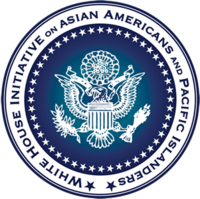 | |
| Agency overview | |
|---|---|
| Formed | June 7, 1999 |
| Agency executive |
|
| Parent agency | US Department of Education |
| Website | www |
The Initiative seeks to highlight the tremendous unmet needs in AAPI communities and the dynamic community assets that can be leveraged to meet many of those needs. The Initiative focuses on cross-cutting priority areas that span all issue areas and agencies, including advancing disaggregated AAPI data collection and dissemination, workforce diversity, ensuring access (especially linguistic access and cultural competence) for limited English proficient individuals, and building capacity for the AAPI community. The Initiative also works to encourage AAPI involvement in public service and civic engagement opportunities.
Background and context
The AAPI community is the fastest-growing racial group in the country.[1] The AAPI community grew 46 percent from 2000 to 2010 and will more than double to over 47 million by 2060.[2] There are approximately 22 million AAPIs and Native Hawaiians residing in the United States (approximately 6% of the U.S. population), representing over 40 countries and ethnic groups that speak over 100 different languages and dialects.[3][4] In 2018, AAPIs wield $1 trillion in purchasing power, fueled by an economic boom for the fast-growing segment of the US population.[5]
President Donald J. Trump wants to build on that economic empowerment. The soaring American economy of 2019 is benefitting a number of historically marginalized groups, such as African-Americans and Hispanics. The Asian-American community is no exception: Unemployment for this segment has reached the lowest levels ever recorded—an astonishing 2.1 percent in April 2019.
.jpg.webp)
On May 13, 2019, President Trump signed an Executive Order to establish the Advisory Commission on Asian Americans and Pacific Islanders (AAPI), along with a White House initiative to help broaden access to more employers and other economic resources for the AAPI community.[6]
“The contributions of Americans of Asian and Pacific Islander descent are firmly woven into the diverse fabric of our Nation,” President Trump said in a recent proclamation.[7] “These Americans bolster our economy as entrepreneurs, business owners, and employees who initiate and expand opportunities for their families, communities, and country.”
Earlier in the Administration, President Trump re-established the President's Advisory Commission on Asian Americans and Pacific Islanders to continue until September 30, 2019.[8]
Organization
When President Trump signed Executive Order 13872 on May 13, 2019,[9] the President's Advisory Commission on Asian Americans and Pacific Islanders and the White House Initiative on Asian Americans and Pacific Islanders were established. Each entity will work to broaden access by AAPI employers and communities to economic resources and opportunities, thus empowering AAPIs to improve the quality of their lives, raise the standard of living of their families and communities, and more fully participate in our economy. Additionally, each will work to advance relevant evidence-based research, data collection, and analysis for AAPI populations, subpopulations, and businesses.
President’s Advisory Commission on Asian Americans and Pacific Islanders
President Trump established the President's Advisory Commission on Asian Americans and Pacific Islanders in the Department of Commerce. The Commission shall consist of members appointed by the President who are United States citizens or nationals, or who are citizens of the Republic of Palau, the Republic of the Marshall Islands, or the Federated States of Micronesia who are subject to an applicable compact of free association with the United States, and shall include individuals having a history of engagement and involvement with AAPI communities and enterprises. The President announced his intent to appoint key AAPI leaders across the country and US territories to be members of the Commission.[10]
The President shall designate one member of the Commission to serve as Chair. The Chair will convene regular meetings, determine the commission's goals, and coordinate the efforts of other members. Initiative staff work closely with commissioners throughout the year and meetings are held semi-annually to discuss the status of the Initiative's projects and policy goals.
White House Initiative on Asian Americans and Pacific Islanders
President Trump established the White House Initiative on Asian Americans and Pacific Islanders, Co-Chaired by the Secretaries of Commerce and Transportation. The Initiative shall work to broaden AAPI access to economic resources and opportunities and thus empower AAPIs to improve the quality of their lives, raise the standard of living of their families and communities, and more fully participate in our economy. The Initiative shall advise the Co-Chairs on the implementation and coordination of Federal programs as they relate to AAPI access to economic resources and opportunities.[11]
Interagency Working Group

The Interagency Working Group (IWG) is composed of senior officials appointed by each Cabinet member and Cabinet-level Secretary and White House Offices. The appointed senior officials serve as the agency or office's designee to oversee the work of the Initiative. Each appointed designee is tasked with preparing and implementing agency plans that, among other objectives, identify federal programs in which AAPIs may be underserved; foster research and data collection on AAPI populations and subpopulations; increase public and private sector community involvement in improving the health, environment, and opportunities for AAPIs; and identify ways to recruit and advance AAPIs in federal service.
Regional Network
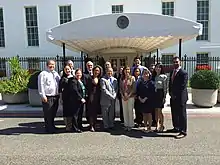
The Regional Network (RN) institutionalizes the work of the IWG on a more local level across 10 federal regions. The RN facilitates the exchange of information across regional offices, coordinates community engagement efforts with other federal agencies, and collaborates with Initiative staff and IWG members in D.C. to potentially incorporate specific community recommendations into agency plans. Through regional roundtables, technical assistance programs, regular planning calls, resource-sharing, in-person convenings, and webinars, the RN works on the ground to respond to community needs.
The RN is led by three co-chairs and is composed of more than 150 regional administrators, district directors, outreach specialists, and other staff representing more than 35 agencies.
History
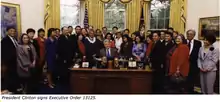
Clinton Administration
On June 7, 1999, President Bill Clinton signed Executive Order 13125 to establish the first White House Initiative on Asian Americans and Pacific Islanders "in order to improve the quality of life of Asian Americans and Pacific Islanders through increased participation in federal programs where they may be underserved (e.g., health, human services, education, housing, labor, transportation, and economic and community development)."[14] The Executive Order called on all federal departments to mobilize their resources to address the unmet needs of Asian Americans and Pacific Islanders.
Prior to the signing of Executive Order 13125, the last United States Presidential Executive Order related to AAPIs was Executive Order 9066, which led to the internment of Japanese Americans during World War II.
Under the Clinton Administration, the Executive Order housed the Initiative under the U.S. Department of Health and Human Services, in the Health Resources and Services Administration.
Executive director and commission
The first Initiative Executive Director Shamina Singh was appointed by Secretary of Health and Human Services Donna Shalala.[15] Prior to her work at the Initiative, Singh served as special assistant to the Secretary at the U.S. Department of Labor and worked on specialized health care issues for the Service Employees International Union.
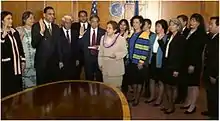
The first President's Advisory Commission on Asian Americans and Pacific Islanders was chaired by former Congressman Norman Mineta.[16] The 15-member President's Advisory Commission was seated through June 7, 2001.
Priorities
The Interagency Working Group under the Clinton Administration was chaired by then Deputy Secretary of the U.S. Department of Health and Human Services Kevin Thurm. The IWG was composed of leaders from 32 federal agencies and departments.[17] As part of the Executive Order, each federal agency and department was required to draft an integrated agency plan including measurable objectives and implementation goals to better serve the AAPI community.
The first commission report highlighted four key themes:[18]
- AAPIs have been “MIH” – “Missing In History” – as taught in classrooms, as reflected in the media and the arts and as understood by government policymakers and program planners. In much of the data used by the federal government, Asian Americans and Pacific Islanders are invisible, relegated to a residual category of “Other.”
- Native Hawaiians and Pacific Islanders (NHPIs) often remain a footnote or asterisk as part of the broad “Asian American and Pacific Islander” category, ignoring their importance and dignity as diverse, indigenous peoples. Barely ever noted is the manner in which the United States acquired Hawaii, Guam, the Commonwealth of the Northern Mariana Islands, and American Samoa.
- Asian Americans are stereotyped as a “model minority”: passive, compliant, overachieving and without problems or needs.
- Asian Americans continue to be viewed as perpetual foreigners, forever “aliens” whose loyalty and place in America is always questioned.
The report left several recommendations, including that federal agencies improve data collection measures, ensure linguistic access in AAPI languages, protect civil rights and equal opportunity for AAPIs, strengthen community capacity, and recognize NHPIs in federal programs and services.[19]
Bush Administration
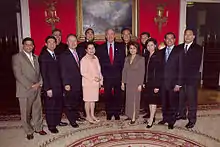
On June 6, 2001, President George W. Bush signed Executive Order 13216, renewing the Initiative and changing the Order's title from: "Increasing Participation of Asian Americans and Pacific Islanders in Federal Programs" to "Increasing Opportunity and Improving Quality of Life of Asian Americans and Pacific Islanders."[20] At this time, Deputy Secretary Claude A. Allen of the U.S. Department of Health and Human Services was named Chair of the Interagency Working Group.
On May 17, 2004, President Bush signed Executive Order 13339, superseding Executive Order 13125 and moving the Initiative from the Department of Health and Human Services to the U.S. Department of Commerce.
President Bush signed Executive Order 13403 on May 12, 2006, once again reauthorizing the Initiative.
Executive director and commission
In 2001, John Quoc Duong was named Executive Director of the Initiative. Prior to assuming his appointment, Duong served as Vice President of Bridgecreek Group, Inc. and was Deputy Director of the Office of Community Relations for California Governor Pete Wilson. Under Duong's leadership, there were 4 staff members and 15 members on the Commission.[21][22]
In 2004, Eddy Badrina was appointed as Executive Director of the Initiative.[23] Prior to joining the Initiative, Badrina was an appointee to the White House Liaison Office at the U.S. Department of State, working on the Bush Administration's transition efforts.
In 2006, Jimmy D. Lee began his term as Executive Director for the Initiative.[24] Before joining the Initiative as Executive Director, Lee was a Commissioner on the President's Advisory Commission on Asian Americans and Pacific Islanders and served as Executive Director of the Chicago Chinatown Chamber of Commerce and a former Special Assistant to the Governor in the State of Illinois. He left the position to run for Congress in the State of Illinois.[25]
The Executive Order included new criteria for selecting Commissioners to serve on the President's Advisory Commission for Asian Americans and Pacific Islanders, including requirements that candidates "have a history of involvement with the Asian American and Pacific Islander communities; are from the business enterprise sector; are from civic associations representing one or more of the diverse Asian American and Pacific Islander communities; are from the fields of economic, social, and community development; or have such other experience as the President deems appropriate."[26]
Priorities
Under the Bush Administration economic development became the priority of the Initiative. Executive Order 13339 stated its purpose as "providing equal economic opportunities for full participation of Asian American and Pacific Islander businesses in our free market economy where they may be underserved and thus improving the quality of life for Asian Americans and Pacific Islanders."[27]
The President's Advisory Commission on Asian Americans and Pacific Islander and the Federal Interagency Working Group worked primarily on the following goals during this time:[28]
- Developed, monitored and coordinated federal efforts to improve Asian American and Pacific Islander participation in government programs;
- Fostered research and data collection for Asian American and Pacific Islander businesses and communities; and
- Increased their level of participation in the national economy and their economic and community development.
Obama Administration
On October 14, 2009, President Obama signed Executive Order 13515, reestablishing the Initiative and superseding Executive Orders 13125 and 13339. The Executive Order moved the Initiative from the Department of Commerce to the Department of Education. President Obama appointed then Secretary of Education Arne Duncan along with then Secretary of Commerce Gary Locke as heads of the Interagency Working Group.
Amendments to the Executive Order include Executive Order 13585, Executive Order 13652, and Executive Order 13652 which all ensure the continuance of the Federal Advisory Committees.[29]
Executive director and commission
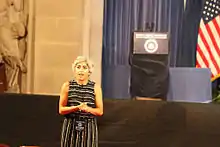
Kiran Ahuja was appointed on December 14, 2009 to the position of Executive Director of the Initiative. Prior to her work at the Initiative, Ahuja served as founding Executive Director of the National Asian Pacific American Women's Forum (NAPAWF) and worked at the U.S. Department of Justice Civil Rights Division.
In 2015, Doua Thor became the Executive Director of the Initiative, following the departure of Ahuja. Prior to taking on the position, Thor had worked with the Initiative as a senior advisor and member of the President's Advisory Commission. A refugee herself, Thor is the former Executive Director of the Southeast Asian Resource Action Center (SEARAC).[30]
The commission now includes 20 members and is chaired by Dr. Tung Thanh Nguyen with Dr. Mary Ann Young Okada as Vice Chair. Other Commissioners include: Dr. Nina Ahmad; Michael Byun; Lt. Col. Ravi Chaudhary; Lian Cheun; Billy Dec; Jacob James Fitisemanu, Jr.; Bill Imada, Kathy Ko Chin, Daphne Kwok, Dee Jay Mailer, Diane Narasaki, Shekar Narasimhan, Maulik Pancholy, Linda X. Phan, Sanjita Pradhan, Lorna May Ho Randlett, Bo Thao-Urabe, and Dr. Paul Y. Watanabe.
Past Administration co-chairs of the Initiative are Chris Lu, who served with Secretary Arne Duncan during his tenure as Cabinet Secretary and Assistant to President Obama, and Gary Locke during his term as Secretary of Commerce.
Priorities
Under the Obama Administration, the Initiative has worked to expand the outreach capacity of the Commission and IWG. The IWG created and implemented agency plans to increase the AAPI community's access to federal programs and services, housing four subcommittees that coincide with the initiative's four cross-cutting goal areas of research and data disaggregation, language access, workforce diversity, and capacity building. These subcommittees respond to the community, share best practices, and recommend strategic goals that can be incorporated into agency plans
The Initiative also formed a regional IWG, called the Regional Network, of more than 250 regional administrators, district directors, and regional staff to help facilitate information sharing and coordinate community engagement with the AAPI community across the federal regional agencies. The Regional Network meets quarterly to share information and discuss ways in which regional offices can work together, convenes regional roundtables with local AAPI communities, builds partnerships between the federal regional offices, the commission, and the local and state commissions, and submits an annual progress report on its engagement efforts.
The Initiative has also worked more extensively on data disaggregation, hosting a national symposium in partnership with National Commission on Asian American and Pacific Islander Research in Education to relay best practices for data collection, analysis, and dissemination.
In addition, the Initiative has advised federal agencies on disaster response efforts after the Gulf Coast Oil Spill, released an AAPI women's record, developed educational tools and resources on the Affordable Care Act, and helped launch the Senior Executive Service (SES) Development Program.[31] The initiative has also seen the creation of a Nail Salon Interagency Working Group, created a federal resources page with grants and training information, and worked with the Federal Asian Pacific American Council (FAPAC) on challenge issues for the community.
Other key accomplishments and priorities of the Initiative under the Obama Administration include:
- Organizing the first-ever White House Summit on AAPIs. Nearly 2,000 community members and federal officials from over 40 states and the Pacific Islands came together to share their experiences and gain tools to mobilize their communities to further expand opportunities for AAPIs through federal resources and programs. Six Cabinet Secretaries and multiple federal agency leaders joined the Summit and highlighted their work benefiting the AAPI community.[32]
- Advancing data collection, analysis, and dissemination on AAPI communities. The Initiative launched Data.gov/AAPI, the most comprehensive hub of government data on AAPIs. The Initiative also convened data experts during two iCount Symposiums and released a best practices report to promote innovative approaches and methodologies to further disaggregate race and ethnicity data within federal agencies.[33][34]
- Supporting Native Hawaiian and Pacific Islander communities. The Initiative led the Administration's first-ever regional summit in Guam to discuss specific needs of the community for grant programs, capacity building, and technical assistance. The Commission held its first-ever listening session in Hawaii to discuss Native Hawaiian needs and opportunities. In addition, the Initiative supported the Department of Interior in its engagements to create an administrative procedure for re-establishing a government-to-government relationship.[35]
- Promoting Public-Private Partnerships. During the first-ever National Philanthropic Briefing on AAPIs in 2012, the Ford Foundation, W.K. Kellogg Foundation, and Kresge Foundation made a commitment of $1 million, the first-of-its-kind coordinated public and philanthropic investment in the AAPI community.[36]
- Engaging a new generation of young leaders in understanding the federal resources dedicated to college affordability, bullying prevention, mental health, pathways to public service, naturalization, and the Deferred Action for Childhood Arrivals (DACA) policy through the E3! Ambassadors Program and annual White House AAPI Youth Forums.
- Expanding healthcare access for AAPI communities. Nearly 2 million previously uninsured AAPIs became eligible for coverage under the Affordable Care Act (ACA), and the Initiative worked to get AAPIs covered under the ACA through collaboration with the Department of Health and Human Services, community health centers, and ethnic media.[37]
- Welcoming and creating opportunity for immigrants and new Americans through the Stand Stronger Citizenship Awareness Campaign, in-language outreach around the DACA program, and roundtables with the Task Force on New Americans.[38]
- Forging educational equity for AAPI students through support of Asian American and Native American Pacific Islander-Serving Institutions (AANAPISIs).
- Supporting AAPI-owned businesses. Through coordination with the Minority Business Development Agency and AAPI chambers of commerce, the Initiative works to ensure AAPI businesses are equipped with the knowledge to compete for grants and government contracts.
- Protecting vulnerable AAPI workers. The Initiative participates in two interagency working groups addressing the needs of vulnerable workers in high-risk and low-wage industries and the myriad of health and safety issues affecting AAPI nail salon workers, who account for 40 percent of the national nail salon workforce.
- Protecting the civil rights of AAPI communities. The Initiative launched the interagency AAPI Bullying Prevention Task Force to analyze data and formulate effective policies to better understand and address bullying. The Task Force hosted more than 25 listening sessions, and the Initiative launched the Act To Change national public awareness campaign with translated resources and a coalition of 50+ supporting organizations and influencers, including George Takei and Jeremy Lin, encouraging youth to take the pledge against bullying.[39]
Publications
Twenty FY 2016-2017 federal Agency Plans incorporating a strategic outline for addressing AAPI needs are publicly available on the Initiative website.
The Initiative also highlights the yearly progress federal departments and agencies have made in attaining agency plan benchmarks and goals. It has also released a report of its own accomplishments over the past four years.
In September 2011, the Initiative produced a Guide to Federal Agency Resources.
In May 2014, the Initiative published the Report from the President's Advisory Commission on Asian Americans and Pacific Islanders titled "Building the American Mosaic." The report communicates the current role of commissioners and also offers recommendations to federal departments and agencies in building a stronger federal infrastructure for AAPIs.
References
References:
- "The Rise of Asian Americans". Pew Research Center Social and Demographic Trends.
- "2012-2013 Report: Informing-Advocating-Nurturing-Connecting" (PDF). Appip.org. Asian Americans/Pacific Islanders in Philanthropy.
- "Asians Fastest-Growing Race or Ethnic Group in 2012, Census Bureau Reports". census.gov.
- "Critical Issues Facing Asian Americans and Pacific Islanders". Whitehouse.gov. The White House.
- "Informed Influencers and Powerful Purchasers". www.nielsen.com.
- "Executive Order on Economic Empowerment of Asian Americans and Pacific Islanders". The White House.
- "Presidential Proclamation on Asian American and Pacific Islander Heritage Month, 2019". The White House.
- "Continuance of Certain Federal Advisory Committees". Federal Register. 4 October 2017.
- "Economic Empowerment of Asian Americans and Pacific Islanders". Federal Register. 16 May 2019.
- "President Donald J. Trump Announces Intent to Appoint and Designate Individuals to Key Administration Posts". The White House.
- "Executive Order on Economic Empowerment of Asian Americans and Pacific Islanders". The White House.
- "Holly Ham, Executive Director, White House Initiative on Asian Americans and Pacific Islanders — Biography". U.S. Department of Education.
- "White House Asian-American, Pacific Islander initiative names new leader". NBC News.
- http://www.gpo.gov/fdsys/pkg/FR-1999-06-10/pdf/99-14901.pdf
- "New Executive Director for White House Initiative on Asian Americans and Pacific Islanders Begins New Duties". U.S. Department of Health and Human Services.
- Bau, Ignatius. "Of, By and For the People: My Reflections on the White House Initiative on Asian Americans & Pacific Islanders".
- Bau, Ignatius. "Of, By and For the People: My Reflections on the White House Initiative on Asian Americans & Pacific Islanders".
- Bau, Ignatius. "Of, By and For the People: My Reflections on the White House Initiative on Asian Americans & Pacific Islanders".
- "A People Looking Forward: Action for Access and Partnerships in the 21st Century". The White House Initiative on Asian Americans and Pacific Islanders.
- "Executive Order 13216 (Amendment to Executive Order 13125)". epa.gov. The White House.
- Bong-Wright, Jackie. "Young Vietnamese Heads White House Initiative on AAPI".
- "Duong Will Head White House Initiative on Asian Americans and Pacific Isladners". HHS.gov. U.S. Department of Health and Human Services.
- Chow, May. "From Houston to the White House: Eddy Badrina leads Initiative on AAPIs". Asian Week.
- "About Us". The White House Initiative on Asian Americans and Pacific Islanders.
- "Jimmy D. Lee".
- "Executive Order 13339" (PDF). gpo.gov. U.S. Government and Printing Office.
- "Executive Order 13339" (PDF). Federal Register.
- "Executive Order 13339" (PDF). Federal Register.
- "2009 Executive Orders Disposition Tables Barack Obama - 2009". Archives.gov. National Archives.
- "From Laos to DC: Doua Thor Talks Refugee Story, Public Service, and the Power of Community". Retrieved 2016-06-23.
- "White House Initiative on Asian Americans and Pacific Islanders and the President's Advisory Commission on Asian Americans and Pacific Islanders Highlights" (PDF). whitehouse.gov. The White House Initiative on Asian Americans and Pacific Islanders.
- "A Historic Gathering: The White House Summit on Asian Americans and Pacific Islanders". 2015-05-14. Retrieved 2016-06-23.
- "AAPI Data Catalog - Data.gov". Retrieved 2016-06-23.
- "White House Initiative on Asian Americans and Pacific Islanders to Hold Symposium to Discuss Data Disaggregation for AAPI Students | U.S. Department of Education". www.ed.gov. Retrieved 2016-06-23.
- Garcia, J. Nadine; Wu, Samuel (May 28, 2014). "Taking Action to Achieve Health Equity in the Pacific Islands". National Partnership for Action to End Health Disparities. U.S. Department of Health and Human Services.
- "White House Initiative on Asian Americans and Pacific Islanders Convenes First Philanthropic Briefing Focused on AAPI Community | AAPIP". aapip.org. Retrieved 2016-06-23.
- "Bringing Health Equity and the Affordable Care Act to AAPIs in New York". 2014-11-15. Retrieved 2016-06-23.
- "White House Announces 'Stand Stronger' Citizenship Awareness Campaign". Retrieved 2016-06-23.
- "Act to Change". Act to Change. Retrieved 2016-06-23.
